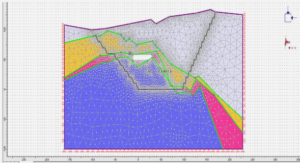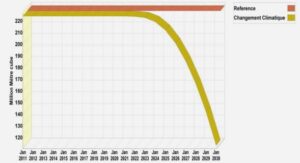The wind industry has been under a period of great expansion for some years. After a slowdown in added capacity in 2013, the next two years set again new records, with more than 50 GW and 60 GW of new installations (World Wind Energy Association, 2015, 2016). Currently, the contribution of wind power is approaching 5% of the total electricity demand worldwide and in some countries (Denmark, Spain, Portugal, Ireland, the United Kingdom and Germany), it contributes to at least 10% of their energy needs (World Wind Energy Association, 2015). After the recent economic recession in many parts of the world (circa 2010), the outlook for wind energy is positive and it is expected that new turbines will be installed at a higher pace in the forthcoming years (Global Wind Energy Council, 2015). However, due to the reduced availability not only of ideal sites —flat and obstacle-free— but of land in general, wind turbines are located close to each other in wind farms. Evidently, economic reasons can also play a role in such occurrence, to maximize the profitability of the land. This causes interference problems owing to the interactions between the turbines themselves and with the wind flow which in turn reduce the efficiency of the array.
In particular, the wind turbine wakes increase the level of turbulence and cause a momentum defect within the wind farm, which may lead to an increase of structural loads on the rotors and to a reduction of the power output, respectively. Moreover, the rise of turbulence along with the apparition of dynamic loads can induce fatigue that may produce considerable damage in the turbines (Jiménez et al., 2008). For these reasons, the prediction of turbulence characteristics in the wakes and its interaction with other turbines is a crucial element to predict the everyday as well as the long-term production of the park. Notably, the accurate prediction of turbulence levels in the wake contributes to improve the estimation of the wake recovery and with it the forecasting of wind resources for the downstream turbines. This issue is of particular relevance if it is considered that linearized models often employed in the industry are not adequate to assess these effects (Palma et al., 2008), due to their inability to model turbulence. For instance, since turbulence enhances mixing in the wake, which in turn permits a faster recovery of the wind speed, neglecting it can produce an underestimation of power production in a park.
When numerical simulations are made of large wind parks, computational limitations oblige us to employ simpler rotor models that, while numerically less expensive, are requested to produce a minimum level of detail in wake features that yields an acceptable reproduction of the interaction of these and the downstream wind turbines as well as other wakes. Amongst the simplest formulations of the rotor model is the Actuator Disk (AD) (Sørensen and Myken, 1992; Ammara et al., 2002) which reproduces the effect of the rotor in the incoming flow by means of a permeable surface in the shape of a disk where flow momentum is lost. In its most basic conception, the AD constitutes a one-dimensional force opposite to the flow, perpendicular to the rotor plane, with no rotation or airfoil properties. It has been shown experimentally (Aubrun et al., 2013) and numerically (Jiménez et al., 2008; Porté-Agel et al., 2011) that the characteristics of the turbulence in the far wake region can be adequately reproduced employing uniformly loaded disks when compared to either a three-bladed model turbine or an actuator line method (Sørensen and Shen, 2002) . Conversely, the numerical representation of the wake field closer to the rotor can noticeably benefit from the introduction of the tangential velocity component, as it has been shown in comparisons with experimental wake data (Porté-Agel et al., 2011) or more sophisticated rotor models (Troldborg et al., 2015).
The wake is defined as the region behind a wind turbine where the velocity of the wind flow is lower compared to that in front of the turbine. In general terms, a wake is generated by the loss of momentum due to the force of the body on the fluid, acting in opposite direction to the flow. Conversely, the force of opposite sign applied on the body itself is know as thrust. The characteristics of the wake depend largely on the geometry of the body and the Reynolds number of the flow. Whereas for streamlined objects the wake is small and of the order of the boundary layer thickness, the wakes of wind turbines can extend over many turbine-diameters behind the rotor.
The wake perimeter is drawn by the shear layer, conceived as the cylindrical region shaped by the helical vortices arising from the tip of the blades, which represents the boundary between the slow wake flow and the outside flow (Crespo et al., 1999). The wake region can be divided in two parts: the near wake is the zone just behind the rotor, of about a few rotor diameters in length (e.g, 1 in Vermeer et al., 2003; 1-3 in Manwell et al., 2002; 2-5 in Crespo et al., 1999; or 1-5 in Medici, 2005). In this region, the blade airfoil design largely influences the flow dynamics as opposed to the downstream zone. This part extends until the shear layer increases its thickness (due to turbulence diffusion) and reaches the centreline of the wake (Vermeer et al., 2003). Beyond this zone is the far wake, where mixing and diffusion continue until the turbulence generated by the turbine and velocity deficit with respect to the free stream flow have disappeared (Manwell et al., 2002). Self-similarity is reached at a considerable distance in the far wake. Using experimental results in the wake of solid disks of diameter D as example, selfsimilarity is reached for distances of x/D > 30 (Johansson and George, 2006) or x/D = 50 (Medici, 2005). Therefore, this type of analysis is of little interest in practical wind energy applications (Medici, 2005). The far wake research is dominated by turbulence processes and interactions of the wake with the ground, the Atmospheric Boundary Layer (ABL) and other turbines (in wind farms). On the other hand, the determination of the near wake characteristics can be influenced by the aerodynamic design, performance and physical processes of power extraction.
Due to the interaction of the turbulent inflow with the turbine blades, a highly complex flow field within the wake region is expected. As torque is produced, rotation is also induced, adding an angular momentum component to the wake flow. Furthermore, changes in the bound circulation along the blades give place to the shedding of strong tip vortices that follow helical trajectories (Ivanell, 2009). Due to different instability mechanisms, vortices break down and form small scale turbulence structures. The primary cause of wind turbine wake destabilization is mutual inductance (vortex pairing) by the tip vortices (Sarmast, 2014).
INTRODUCTION |





